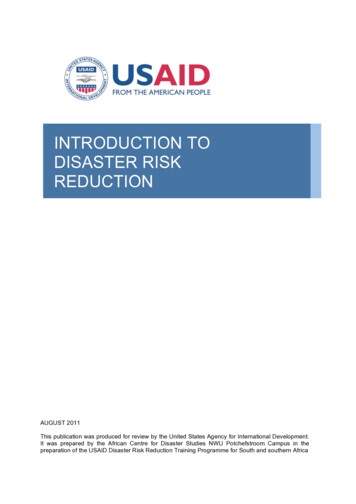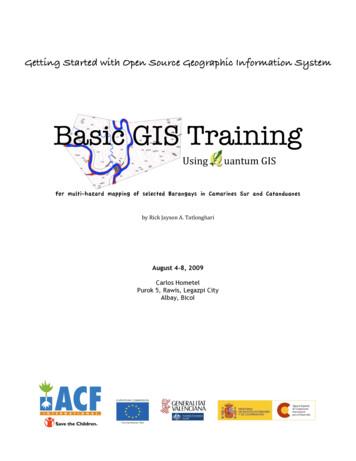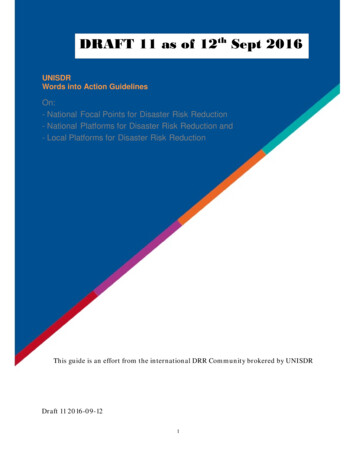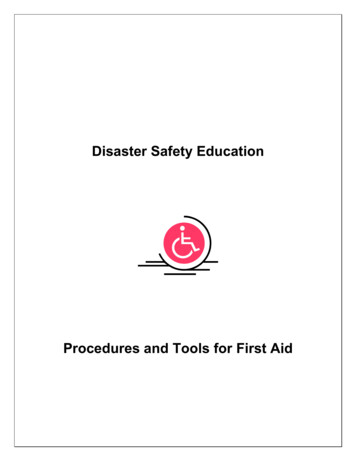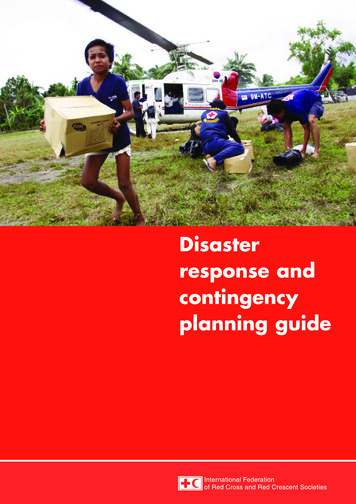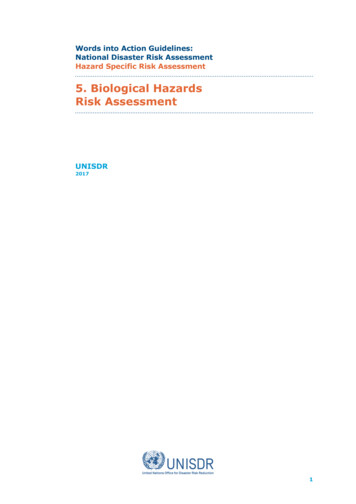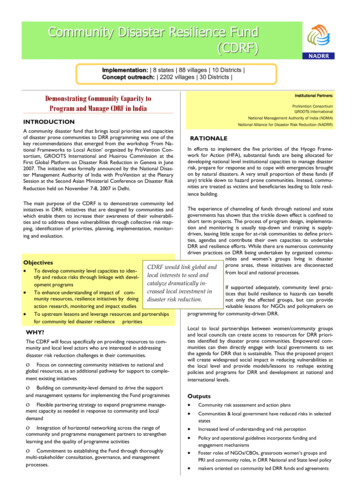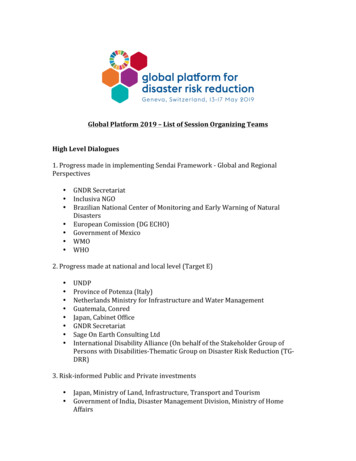
Transcription
1INTRODUCTIONGeneral Planning and Development ModelIn an ideal scenario, a particular local government unit (LGU) manages its own growth andchange through a body of plans with varying scope and time frame. The term “ideal”,however, does not imply a utopian, unrealistic or unattainable dream. It simply means ascenario that does not exist as yet. Nevertheless, it is the scenario that the LocalGovernment Code (LGC) of 1991 (RA 7160) wants every LGU to achieve. With the aid ofvarious plans, LGUs are expected to more effectively manage their own local development.Section 20 of the LGC mandates LGUs to prepare a comprehensive land use plan (CLUP)enacted through a zoning ordinance, while Sections 106 and 109 of the same Codemandate the LGUs to prepare comprehensive multi-sectoral development plans (CDP) andpublic investment programs.It is clear from the above-cited provisions of the Code that LGUs are required to prepare twoplans: the CLUP and the CDP.These plans influence public and private sector investments which have the cumulativeeffects of making available goods and services whose quality has been improved, andmaking them more accessible to the people, thereby raising the level of their well-being.Any change in the level of welfare of the population, on one hand is expected to createcorresponding changes in the character and configuration of the land and other physicalresources of the locality. On the other hand, it may be noted that any improvement in thelevel of social and economic well-being of the local population will almost always entaildeterioration in the quality or quantity of the physical environment. How to achievedevelopment objectives without necessarily sacrificing the environment poses a majorchallenge to local development planning and management.As the LGU gains longer experience in managing its own growth and change, especiallywhen the Sanggunian is ever alert for possibilities to formulate regulatory policies and tofurther support the implementation of plans, programs and projects with neededdevelopment regulations, its institutional capacity will be enhanced considerably. (SeeFigure 1 - A Local Planning and Development Model)The Relationship between the Comprehensive Development Plan (CDP) and theComprehensive Land Use Plan (CLUP)The Comprehensive Land Use Plan (CLUP) and the CDP are distinct and separate. Theterm “comprehensive” in the CLUP is understood in its geographical, territorial sense, whilethe term “comprehensive” in the CDP has to be understood in the sense of “multi-sectoral”development.On one hand, the CLUP can well be regarded as the plan for the long-term management ofthe local territory. As the skeletal-circulatory framework of the territory’s physicaldevelopment, it identifies areas where development can and cannot be located and directspublic and private investments accordingly. The CDP, on the other hand, is the action planutilized by every local administration to develop and implement the proper sectoral andcross-sectoral programs and projects in the proper location to put flesh on the skeleton as itwere, gradually and incrementally, until the desired shape or form of development iseventually attained over the long term. This is consistent with the definition of planning as“public control of the pattern of development”.INTRODUCTION
2Figure 1 - A LOCAL PLANNING AND DEVELOPMENT MODELCOMPREHENSIVE LAND USE PLAN (CLUP)LONG – TERMFRAMEWORK LEMENTATIONINSTRUMENTSINFRASTRUCTUREPOLICIESOTHER REGULATORY MEASURESCOMPREHENSIVE DEVELOPMENT PLANSOCIALECONOMICINFRALOCAL DEVELOPMENT INVESTMENTPROGRAMTERM – BASED AGENDAENVI. MGT.INSTITUTIONALLEGISLATIVE SUPPORTMEASURESEXECUTIVE & LEGISLATIVE AGENDA ND POLICIESZONING ORDINANCEMULTI-YEAR, MULTISECTORALDEVELOPMENT PLANOUTPUTSPROTECTIONLAND POLICIESANNUAL INVESTMENTPROGRAM IMPROVED PUBLIC SERVICES NEW OR IMPROVED PUBLIC FACILITIES/ INFRASTRUCTURE INCREASED PUBLIC AWARENESS & PARTICIPATIONANNUALBUDGET INCREASED PRIVATE SECTORINVESTMENT IN LOCAL ECONOMIC& SOCIAL DEVELOPMENT CHANGE IN SOCIAL & ECONOMIC WELL-BEING OF RESIDENTS CHANGE IN CONFIGURATION & QUALITY OF THE PHYSICAL ENVIRONMENT CHANGE IN LOCAL INSTITUTIONAL CAPACITIESChart designed by Prof. Ernesto M. SeroteA common concern often raised by local planners is how to keep the long-term plan frombeing thrown away with every change in administration. The permanent answer to thisconcern lies precisely in having a separate CLUP from a CDP. The CLUP, once enacted intoa zoning ordinance (Sec. 20, c), becomes a law. It remains in effect even after theincumbent officials have been replaced. Being a law, the CLUP-turned Zoning Ordinancecannot be simply “thrown away” without going through the proper legislative procedures forrepealing or amending an ordinance. The truth of the matter is, the long-term CLUP, once inplace, can no longer be claimed by, nor attributed to a particular administration. Rather, theCLUP belongs to the people. It is the “people’s plan”.One thing that bolsters the interpretation that the CLUP and CDP are distinct and separate isthe fact that the responsibility for each plan is given to separate bodies in the LGU. TheCLUP is assigned to the Sanggunian as provided for in Sections 447, 458 and 468 (Powers,Duties, Functions and Compensation of the Sangguniang Bayan, Panlungsod andPanlalawigan, respectively) of the Local Government Code; whereas the CDP is theresponsibility of the LDC as provided for under Sections 106 (Local Development Councils)and 109 (Functions of Local Development Councils) of RA 7160. The Code has correctlyassigned responsibility for the CLUP to the Sanggunian considering that most if not all of theinstruments for implementing the CLUP involve regulating the use of lands that are mainlyprivately held and this requires the exercise of the political powers of the LGU throughlegislative action by the Sanggunian.With the CLUP separated from the CDP, the review process by the Provincial Land UseCommittee (PLUC) will be immensely simplified. The Code requires a review by theprovincial government of the CLUP, not the CDP, of component cities and municipalities.INTRODUCTION
3It is highly desirable that the CLUP be completed ahead of the CDP. This is to ensure thatthe location policies in the CLUP will guide the identification screening and prioritization ofprograms and projects in the CDP (see Figure 2 - Simplified Planning Process). Consideringthat some public investments, especially of the “hard project” type, have a powerful impacton the long-term structuring of the built environment and on land use change in general,such projects should be properly screened to ensure that they are in consonance with, if notactually supportive of the preferred spatial strategy for the community.Figure 2 - Simplified Planning ProcessELABORATION OF ENDSVISIONCLUPELEMENTDESCRIP NTREALITYECOLOGICALPROFILE, LDIS,MAPSVISION TSSPECIFICATIONOF MEANSSPATIALSTRATEGIESDEVELOPMENT P OLICIES STRATEGIES P ROGRAMS P ROJECTSWhat it takesto closethe gapWhat can bereasona blydoneIn 3 years LEGISLATIONSThe CLUP is in itself a rich source of programs, projects and ideas for legislation. Theprograms and projects identified in the CLUP however, invariably take a long time to carryout. On the other hand, the CDP has a relatively short timeframe. This, however, should notbe used as a reason for ignoring the long-term programs of the CLUP and implementinginstead other projects with shorter timeframes. Rather, the short time frame of the CDPshould be used to carry out the long-term CLUP programs in phases. This way, localdevelopment will appear less disjointed, arbitrary, or random but will acquire stability,continuity and rationality.The CDP can be regarded as an action plan and an implementing instrument of the CLUP.By having a CLUP which serves as a long-term guide for the physical development of thelocality and the CDP that is multi-year, but serves as the basis for crafting an Executive andLegislative Agenda (ELA) which is co-terminus with the term of local elective officials, thereis an assurance of continuity, rationality and stability of local development efforts.It is the CDP or rather, the CDP-based ELA that is associated with a particularadministration.The CLUP and the CDP may be prepared in an iterative way. For simplicity, the preparationof the CLUP and CDP can be divided into four (4) modules consistent with the capabilitybuilding approach (Figure 3 - CLUP-CDP Process Flow).INTRODUCTION
4Each module is described briefly as follows:1. Module 1 – Formulation of new goals or revalidating and/or revising the existingvision statement. The outputs of this module are as follows:a. Revalidated/ revised vision statementb. Vision elements and their respective descriptors and success indicatorsc. Vision – reality gap which will eventually be transformed into sectoral goalsFigure 3- CLUP – CDP Process FlowMODULE 1MODULE 2MODULE 3ALTERNATIVESPATIAL STRATGEIESVISION &ASPIRATIONSFOR THE LGUDEMAND – SUPPLYBALANCING OF LANDRESOURCESEXISTING DATA &MAPSSIEVE MAPPINGVISION –REALITY GAPANALYSISPUBLIC CONSULTATIONNO. 2REVIEW/ ASSESSMENT/IMPACT M & EINITIALCHARACTERIZATIONBY AREA, BY SECTORDATAGAPSVALIDATION OFDATASTATISTICALCOMPENDIUMFURTHERRESEARCH &MAP OVERLAYANALYSISREFINEDVISION & ER- INTRAAREA ANALYSISDEVELOPMENTPOTENTIALS &PROBLEMSDETAILED LANDUSE PLANGENERAL LAND USEPLAN & URBAN LANDUSE NSULTATIONNO. 3PUBLICCONSULTATIONNO. 1POLICYOPTIONSPREFERRED SPATIALSTRATEGY OF DESIREDURBAN TIVES &TARGETSOTHER LOCALLEGISLATIONSSECTORAL PROGRAMS,PROJECTS &ACTIVITIESINVESTMENT PROGRAMMING& BUDGETINGLEGEND:SECTORALDEVELOPMENT PLANSA PROCESS OR ACTIVITYINPUT TO, OR OUTPUT FROM APROCESS OR ACTIVITYOVERLAP WITH THENEXT MODULEANNUALGENERAL FUNDBUDGETMODULE 42. Module 2 – Generation of the planning database consisting of statistics and mapsand analytical tools and techniques to derive various indicators of development orunderdevelopment, of problems and constraints as well as opportunities andchallenges for development. The outputs of this module are as follows:a. Updated ecological profile of the planning areab. Matrix of Local Development Indicators (Statistical Compendium)c. Accomplished “Problem – Solution Matrix”3. Module 3 – Formulation of the Provincial Physical Framework Plan (PPFP) in thecase of the province and the CLUP in the case of cities and municipalities. Thisinvolves undertaking the following activities:INTRODUCTION
5a. Generation of alternative spatial strategies taking into account the regional andprovincial spatial strategy and choosing the most desirable alternative for theprovince or city/municipality, as the case may be.b. Formulation of policies on settlements, production, infrastructure and protectionareas consistent with the preferred strategy.c. Formulation of implementation tools, e.g., zoning ordinanceThe outputs of activities under this module are as follows:a. Draft Provincial Physical Framework Plan and / or City/Municipal CLUPb. Policy maps printed at suitable scalec. Draft Zoning Ordinance4. Module 4 – Preparation of the Multi-Year Provincial/City/Municipal CDP. The mainactivities under this module are as follows:a.b.c.d.e.Formulation of sectoral goals, objectives and targetsPrioritization of sectoral programs, projects and activitiesPreparation of the Local Development Investment Program (LDIP)Identification of new legislations needed to carry out the sectoral plansPreparation of the capacity development programIntegrating NGA Requirements and Cross-Sectoral Concerns into the CDPOne dimension of rationalized planning is the reduction of the number of plans that LGUsmust prepare and the integration of cross-sectoral concerns in the planning process. Thisimplies that national government agencies (NGAs) advocating or requiring LGUs to preparecertain sectoral, area, thematic or systems plan must integrate these requirements intoeither the CLUP or the CDP, as the case may be, and allow the local planning structure andprocesses to respond to these requirements.There are over twenty (20) different plans required by NGAs of LGUs over and above thetwo (2) Code-mandated plans – the CLUP and CDP. To rationalize the practice to the extentof integrating NGA requirements substantively and procedurally into local planning, at leasttwo (2) pre-conditions must be satisfied:1. The local planning structure, that is, the Local Development Council (LDC) and itssectoral and functional committees, are in place.If the LDC is already existing and properly functioning, there will always be a planning body that willrespond to any conceivable requirement of the national government.a. NGAs need not go to the extent of creating a new planning body or structure toproduce their desired plan outputs. If there is an existing NGA office operating in theLGU, its officers and staff should be invited to join the relevant sectoral or functionalcommittee.2. The local plans are truly comprehensive, meaning, the CLUP covers the entire LGUterritorial jurisdiction, both land and water; and the CDP embraces all developmentsectors and sub-sectors, including the concerns of each.In this connection, NGAs requiring LGUs to produce certain planning outputs ought tolearn to utilize the planning structures and processes that are already in place in theLGUs.INTRODUCTION
6If the CDP is truly comprehensive, then every possible subject of planning and development canbe subsumed under a particular sector or a combination of sectors in the CDP.The NGA-mandated plans listed below need not be prepared by planning bodies createdoutside of the LDC and/or its sectoral or functional committees. In fact these plans alreadyfall within the concerns of existing sectoral committees. In the case of area, thematic orsystems plan that involves several sectors, functional committees could be formed drawingmembership from the sectoral committees themselves.1. Action Plan for the Council for the Protection of Children2. Annual Culture and Arts Plan3. Agriculture and Fisheries Management Plan4. Coconut Development Plan5. Local Entrepreneurship Development Plan6. Local Tourism Development Plan7. Small and Medium Enterprise Development PlanSome development issues can be confined within the conceptual boundaries of a particularsector. Issues of this nature are better handled by specific sectors. Other issues however,are common to two or more sectors and such issues can be addressed jointly by the sectorsconcerned through inter-sectoral consultations, round-robin fashion (see Figure 4 - Intersectoral Consultations and Table 1- Sample Issues Common to Sectoral Plans). Complexdevelopment issues such as that of poverty, disaster risk management, gender anddevelopment, to name a few, need to be addressed either by a multi-sectoral functionalcommittee or by the LDC acting as a committee of the whole.Figure 4 - Inter-sectoral ConsultationsSOCIAL158ENVIRONME NTALECONOMIC671094INFRASTRUCTURE& LAND USE2INST ITUTIONAL3INTRODUCTION
7Some of the plans that require inter-sectoral functional committees are the following:1.2.3.4.5.6.Disaster Management PlanLocal Poverty Reduction PlanGender and Development PlanSustainable Development PlanFood Security PlanIntegrated Area Community Peace and Order and Public Safety PlanTable 1 - Sample Issues Common to Sectoral PlansSECTORSISSUESSocial - Economic Household income and expenditureLabor force participation rateEmployment, unemployment, underemploymentJob-related health risksEconomic - Institutional Private investment incentives and regulations (local ordinances)Budget allocation for economic development (% of total budget)Economic performance of public enterprisesLand Use/Infrastructure- Institutional Land use planning and regulationBudget allocation for roads and bridges, drainage and sewerage, water and power supplySpace and buildings for the administration of justice, police and fire stations, jails an detentioncells, etc.Environmental – Land Use/Infrastructure Infrastructure vulnerable to environmental hazardsInfrastructure to mitigate or prevent environmental disastersSustainability in land use patternsSocial – Environmental Domestic waste generation disposalAir pollution by sourcePopulation to land ratioSocial - Institutional Social development budget as percent of total budget for socialized housing, livelihood services,health, welfare, education, protective services, etc.Mechanisms for promoting people participation in local governanceMechanisms to ensure accountability and transparency in public office Social – Land Use/Infrastructure Infrastructure to ensure social access (public transport service area, access ramps fordisabled, traffic-related accident rate)Infrastructure to ensure public safety and convenience (pedestrian friendly street furniture); forpublic recreation (outdoors and indoors)Impact of infrastructure on land use and population distributionEconomic - Environmental Sustainability in resource useEconomic activities vulnerable to environmental hazardsEffluent generation and disposalEnvironmental - Institutional Local policy (regulation) on environmental regulationLocal budget allocation as percent of total budget on environmental and natural resourcesmanagementLocal programs on environmental rehabilitation Economic support infrastructure (appropriateness and adequacy)Land use pattern that promotes economic efficiency Economic – Land Use/ InfrastructureINTRODUCTION
8It would certainly make a difference if the different sectoral and functional committees at thecity or municipal level were involved in the preparation of these thematic or systems plans.The outputs of each sectoral plan or inter-sectoral consultation may be grouped into twotypes: programs and projects and new policies, or new legislations. The first type of outputswill serve as the source of inputs to the local development investment program. The secondtype of outputs will be included in the legislative agenda of the Sanggunian.Synchronization and Harmonization of Planning, Investment Programming, RevenueAdministration, Budgeting and Expenditure Management at the Local LevelOn March 8, 2007, four national agencies, namely the DILG, National EconomicDevelopment Authority (NEDA), Department of Budget and Management (DBM) and theDepartment of Finance (DOF), collectively known as the Oversight Agencies (OAs),approved and issued Joint Memorandum Circular (JMC) No. 001 series of 2007. Thefundamental intent of this JMC is to harmonize the guidebooks and manuals prepared by theOversight Agencies; define the individual and joint roles and functions of the OversightAgencies in relation to planning, investment programming, revenue administration,budgeting and expenditure management in order to facilitate the crafting of a plan-basedbudget at the local level, using tools and instruments and adopting strategies andapproaches that harness multi-stakeholder participation; establish and strengthen verticaland horizontal linkages among the network of plans, investment programs and budgets at alllevels of the administrative hierarchy; and capitalize on the Local Government Codemandated structure – the Local Development Council (LDC) as the principal vehicle forplanning and investment programming activities.In the ambit of this JMC, local planning at the city and municipal level focuses on thepreparation of the comprehensive multi-sectoral development plan, which springs from aprocess that, at a certain point also yields a CLUP as a separate and distinct document.Among the significant features of the JMC involves the following:1. providing opportunities for interface between national government agencies (NGAs)and local government units (LGUs), and2. strengthening the complementation between provinces and their component citiesand municipalities.The first is to emphasize the role of the local government units (LGUs) as partners of thenational government in national development and as collaborators and cooperators in localdevelopment. The second is to establish the significant role of the province in formulatingdevelopment plans, policies and strategies that are built on the development concerns,thrusts and programs of it component cities and municipalities, while ensuring that localdevelopment goals and objectives are attuned with regional and national priorities.The Relationship between the Province and its Component LGUs in the PlanFormulation ProcessIn the entire gamut of establishing a rationalized local planning system and the capabilitybuilding activities that it entails, the province is viewed as the most critical point of entry ofinterventions. Sectoral planning experts found orBeing at the apex of the 3-tier local governmenttrained at the provincial level can serve as mentorssystem, the province could be the mostto their municipal counterparts. And since provincialeffective channel for effecting the integration ofassistance to component LGUs actually forms part ofplans and planning processes at the local level.the regular functions of provincial governmentINTRODUCTION
9officers, their extension services could be availed of at any time. Establishing a pool oftechnical experts among provincial government functionaries is a more cost-effectiveapproach to technology transfer than engaging the services of planning consultants.In terms of vertical integration of plans, the Provincial Governor serves as the vital link ofLGUs to the national government by virtue of his/her membership in the RegionalDevelopment Council. At the lower level, the power of automatic review of all policies andactions of component LGUs by the Sangguniang Panlalawigan can be utilized to effectreconciliation and integration between the plans of component LGUs and those of theprovincial government. The provincial government can utilize its review and oversightpowers to resolves issues between adjoining municipalities.Interface between NGAs and LGUs in Local PlanningUnder the current devolution policy, LGUs are no longer to be treated as subordinates to, butas partners of the national government in the attainment of national goals (Sec. 2 ([a], RA7160).NGAs are enjoined to utilize the existing local planning structure, the LDC and avoid creatingnew ones in the process of preparing sectoral, thematic or systems plans. They are alsoencouraged to learn to integrate their planning methodologies and analytical techniques intothe regular planning process. In this connection, all NGA officers operating in the LGU areencouraged to join relevant sectoral and functional committees in the LDC.NGAs can serve as coach or mentor on technical matters of their expertise in the followingplanning tasks, such as:1. Building and maintaining the sectoral database by generating sectoral data for theupdating of the ecological profile, processing of data to generate development indicatorsfor inclusion in the Local Development Indicators System, and assisting in the conduct ofimpact monitoring and evaluation.2. Teaching and applying analytical and planning tools and techniques peculiar to thesector to their local counterparts for the latter to be able to produce their own sectoralplan. This sectoral plan may incorporate the particular thematic or system plan requiredby the NGA.3. Participating in public consultations to provide information on applicable national goals,laws and policies and programs and to help reconcile local goals and policies with thoseof the national.4. Engaging in budget advocacy to encourage the LGU to give priority to local sectoralprograms and projects that will supplement or complement the effects of on-going orproposed national programs.The Synchronized Local Planning and Budgeting Calendar (SLPBC)An important adjunct to the JMC is a Synchronized Local Planning and Budgeting Calendar(SLPBC). A unique element in the SLPBC is its scope, which covers a 3 – year period. Thecalendar specifies activities that are undertaken only during an election year, whenincumbent local government officials end their tenure of office and new or re-elected onesbegin theirs. It also provides a guide for participation by the key actors in the planning,investment programming, revenue administration, budgeting, and expenditure management.INTRODUCTION
101. As an Instrument for SynchronizationThe SLPBC lists down the deadlines and milestone dates for budgeting activities asmandated by law. Then, planning, investment programming and revenue administrationactivities are “fitted’ into or synchronized with the budget calendar to allow them to catchup with the budgeting process. This is particularly important so that programs, projectsand activities identified to carry the LGU towards the attainment of its vision, goals andobjectives are prioritized in the 3-year local development investment program (LDIP), theannual investment program (AIP), and in the local annual or supplemental budget. Thecalendar also suggests the timelines during which the province and its component LGUsmay conduct activities jointly or independently but simultaneously, and the period whenoutputs of such independently-conducted activities should be completed andconsolidated at the provincial level.2. As an Instrument that Provides Opportunities for Complementation between the Provinceand its Component Cities and MunicipalitiesThe calendar suggests the periods when complementation between the province and itscomponent cities and/ or municipalities can take place. It sets the stage for:a. Establishing proper coordination between the province and its component LGUs toensure that their vision, strategic directions, goals and objectives as embodied intheir respective development plans are consistent and supportive of one another;b. Soliciting and consolidating support for programs, projects and activities arefacilitated to redound to the mutual and/or common benefit of all LGUs within theterritorial jurisdiction of the province; andc. The higher LGU to take cognizance of the priorities and needs of the lower LGU, andvice versa.3. As an Instrument that Provides Opportunities for Interface between the NationalGovernment Agencies and Local Government UnitsThe SLPBC provides avenues and suggests periods where and when NGAs and LGUscan engage each other, especially in the matter of technical assistance, funding support,inclusion of LGU priorities in NGA programs and projects and vice versa, as well as inthe determination of legislative actions on the part of the LGU to support NGA programsthat will impact on the LGU.Cross Referencing of Guidebooks and ManualsThe sets of manuals and guidebooks that the Oversight Agencies have developed to serveas reference materials for local planning, investment programming, revenue administration,and budgeting and expenditure management are intended to build the capacity of LGUs informulating their plans, investment programs, budgets and revenue administrationmeasures. The tools and techniques being offered in one manual or guidebook may also befound in another. This may construed as an iteration of the desirability or applicability ofsuch tools and/or techniques for a particular phase or step in the planning, investmentprogramming, revenue administration, budgeting, and expenditure management process. Tosome LGUs, going through all these manuals volume by volume, or chapter by chapter withor without coaching assistance from the agency concerned may be an easy task. But to themany others, such endeavor may prove to be tedious and daunting. To address thisconcern, a cross-referencing guide has been developed. Part I of the guide lists downvarious tools, techniques and methodology that may be adopted in the various steps of theplanning, investment programming, budgeting and revenue administration process, andINTRODUCTION
11indicating in what specific guidebook and manual can they be found; and Part II describesor annotates each of these tools, techniques and methodology.This Guide is one of the suggested reference documents.Approaches to CDP Preparation: Inclusive, Participatory, and ConsultativeThe LDC is one of the two more important components of the planning structure; theSanggunian being the other one. They are the bodies that lay down policy guidelines andtake decisions regarding the direction, character and objectives of local development.Together with the Congressman’s representative, they comprise the political component ofthe local planning structure.The most ample avenue for multi-stakeholder participation in local planning anddevelopment is the allocation to non-governmental organizations of one-fourth of the totalmembership of the LDC. The Code explicitly directs LGUs to promote the establishment andoperation of people’s and non-governmental organizations (POs and NGOs) as activepartners in the pursuit of local autonomy (Section 34, RA 7160).The technical component of the local planning structure is composed of non-elective officialsof the LGU, particularly the LPDO, LGU department heads, local special bodies, sectoraland/or functional committees of the LDC, chiefs of national government agencies in the LGUand private sector representatives. It is in the sectoral of functional committees and/or otherlocal special bodies where other stakeholders who did not gain accreditation as members ofthe LDC can get to participate in the planning process.The steps in the planning process where multi-stakeholder participation can be harnessedare listed below.Stage 1: Generating the Planning Data BaseTechnical inputs in the areas of data generation, analysis and presentation are mainly theresponsibility of the technical compon
INTRODUCTION 4 Each module is described briefly as follows: 1. Module 1 - Formulation of new goals or revalidating and/or revising the existing vision statement. The outputs of this module are as follows: a. Revalidated/ revised vision statement
